McLaughlin & Harvey profits halve to £5.9m
Private contractor McLaughlin & Harvey saw pre-tax profits slide to £5.9m from £11.5m last year as extra costs from Covid safe working took their toll on the business.
But despite these challenges, the Cheevers family-owned group held revenue at a near-record level of £480m, down 6% from the year before, with operating margins at 1.1%.
Both the construction and civil engineering division, which contributed £417m of total revenue, continued to trade profitably despite the additional challenges and extra costs that Covid brought.
Over the year the group, which employs 800 staff out of offices in offices in Belfast, Glasgow, London, Edinburgh, Liverpool and Bristol, received £2.2m in furlough support cash from Government.
Finance director David O’Neill said that other smaller group businesses – distribution and the environmental landfill business – also both performed strongly last year, building a platform for the year group ahead.
“The current order book, tender opportunities and performance for 2021 are very healthy and we anticipate a strong performance,” said O’Neill.
“The fundamentals of each of the businesses with McLaughlin & Harvey Group are strong. The balance sheet for the group shows net assets of £57.6m supported by net cash of £69.9m.”
In June, McLaughlin & Harvey launched a new dedicated fit-out business called WorkSpace to offer clients a range of services spanning build, fit out, facilities management, bespoke joinery, and commercial furniture.
Richard Cheevers, McLaughlin & Harvey Director, said: “The company has built a strong reputation for delivering large scale construction and civil engineering schemes over many years, and recently the directors felt there was a need to create a dedicated division for projects outside the scope and scale of those traditionally associated with McLaughlin & Harvey.

Did you miss our previous article…
https://www.arizonasolarsociety.com/?p=131
4 Ways to Improve Collaboration in Construction

As construction projects become more complex, effective collaboration is increasingly becoming a key factor in completing projects on time and within budget while delivering a quality product to the client. Good collaboration leads to many benefits like innovation, time and cost-saving, added value for the client, reduced errors, and unnecessary rework.
![]()
Did you miss our previous article…
https://www.arizonasolarsociety.com/?p=127
7 Things to Know About the Sustainable Future of Construction
There have been warning signs in the construction sector for years. The industry creates high levels of physical and digital waste, with 10-15% of materials wasted on every build.
Construction and the built environment account for nearly 38% of all energy-related carbon emissions around the world. And what’s more, we’re battling low productivity and a growing skills shortage. From an environmental, social and economic perspective, it’s simply not sustainable.
But crucially, there’s greater appetite for change in construction than ever before. At two events, London Build and the Festival of Digital Construction, panellists came together to discuss the opportunities for change in the industry.
7 key takeaways on the future of sustainability in construction
1. Incremental change won’t cut it: we need a paradigm shift
The construction industry has been doing the same things for a long time. According to Dale Sinclair, Director of Innovation, EMEA at AECOM, you have to look to the beginning of the twentieth century for the last major innovations like steel and drywall. “If you think about the Empire State Building and the speed it was constructed, that would still be impressive today,” he noted.
Many of the recent improvements in the industry have focused on optimising traditional approaches – but with pressures like the climate crisis and population growth, we need more radical change. As Jaimie Johnson, Head of Global Systems at Bryden Wood put it, “We can’t use traditional techniques to meet population growth. We’ll kill the planet before we house the planet.”
The construction industry will have a huge impact on the future of the build environment, affecting the lives of people hundreds of years from now – as Emilia Hagberg, Senior Sustainability Manager at Skanska, explained. Whatever lens you use, it’s time for construction to do something fundamentally different.
2. There’s a carrot, as well as a stick, for improving sustainability
Companies are facing very real commercial pressures to become more sustainable. Investors want to know that companies are dealing with the risk of climate change, by adapting their business models. There’s greater public and government pressure, which may result in binding regulations.
And critically, owners are beginning to demand greater sustainability, from construction through to operations. Tom Blankendaal, Project Manager, Circular Economy at BAM, shared a story of working with a Dutch bank to create a more sustainable design. “We eventually redesigned the whole project with a trade-off matrix on different sustainability factors, such as energy usage, circularity and total cost of ownership. In the end, we made some very radical design decisions.”
There are also commercial benefits. As Dr Bonahis Oko, Sustainability, Carbon and Environmental Lead at Bouyges Energy Services explained, companies should recognise this “carrot” as well as the “stick.” “Sustainability measures often drive greater efficiency on projects: for example, reducing mistakes also reduces waste. It’s important to look ahead too. Think of sustainability as a factor in the future of the business: an R&D investment rather than just an obligation to fulfil.”
3. True sustainability accounts for the whole life of an asset, so adaptability matters
For a meaningful view of an asset’s sustainability, owners have to consider its whole life emissions – which can open up new ways of thinking. As Dale at AECOM explained, “The construction of a building only accounts for 20% of its whole life costs. If you make it 20% more operationally efficient over its lifetime, you effectively get the building for free.”
Adaptability is essential for maximising a building’s usefulness, prompting a move to long life, loose fit assets. “The most sustainable building is the one that already exists,” explained Az Jasat, Senior Industry Manager, Industrialised Construction, Autodesk.
Jaimie at Bryden Wood recommended we take inspiration from the Victorians, who built incredible overengineered brick buildings which have been converted to many uses over the years, from water stations to climbing walls to offices to flats. “Let’s be the modern Victorians and create the kind of infrastructure that’s superbly well-built for a 150-year lifecycle,” he said.
4. Industrialised construction and design for manufacture and assembly (DFMA) will be critical
By applying manufacturing techniques to the built environment, industrialised construction and DFMA can increase the efficiency and reduce the emissions of projects. According to Az at Autodesk, “these two movements are our best chance of turning this ship around.”
Going one step further, some organisations are exploring the potential of platforms in construction: using consistent components and processes to construct a wide range of buildings, in a similar approach to furniture designs at IKEA.
Jaimie at Bryden Wood explained how the Construction Innovation Hub examined the UK’s public sector construction pipeline across every department. The project found that 70% of the total pipeline could be constructed with the same structural kit of parts, the equivalent of £35bn of assets.
“More than half of the space in schools, hospitals and prisons isn’t sector specific; it might be hallways, toilets, storage or bedrooms,” he said. “If you use the same products and processes across these platforms, there’s much more scope to optimise the components to make them as sustainable as possible.” By using common components on a project called The Forge in London, Bryden Wood saved 20% of the embodied carbon on the build.
5. Both old and new materials have huge potential
Re-evaluating which materials are used in construction – and how – will be critical. As Frank Blande, Senior Sustainability Manager at Multiplex, highlighted, concrete and steel are the two biggest emitters in construction’s carbon footprint.
Innovations in materials science could help to solve this issue, as could the renaissance of older building options. Tom at BAM advocated the potential of engineered wood, as a means of not only reducing carbon emissions but capturing them. The largest timber tower in the world was recently completed in Norway, reaching 18 storeys.
There are many elements that impact the sustainability of materials, so better data will also help teams to make more informed decisions about pay offs. Tools like the Embodied Carbon Calculator are already supporting client dialogues. Tony Saracino, Senior Sustainability Success Manager at Autodesk, advocated harmonised ISO standards for material profiles, to take the industry away from rule of thumb estimations.
Better data also creates the opportunity for materials passports, so that components can be re-used; given that currently 54% of demolition materials go into landfill, this could have a substantial impact.
6. Data will be the force behind all of these changes
Creating a more sustainable industry must start with data. As Frank at Multiplex explained, “Clear and accurate data helps us to better understand where we actually are – our sustainability baseline. It’s then possible to put data-driven strategies in place. As a sustainability team, we’re working with other disciplines across the business to get accurate data in place and set minimum data requirements that cover the business, supply chain and collaborators.”
Making this information available to project decision makers will help to improve design management, planning and quality. Data can also support closer collaboration with clients. AECOM is currently working with Autodesk on a viewer that simplifies information into a really intuitive interface: allowing everyone to get to grips with the data and understand the implications of the design.
However, organisations can encounter challenges with data management: currently lots of sustainability managers’ time may be spent collating siloed information manually, so automating data capture and analysis will be hugely valuable. Going forward, creating feedback loops about the real-world operations of buildings – through tools like digital twins – will also be key.
7. All the stars are aligned: now it’s up to the industry
Sustainability presents significant opportunities for construction, but there are widespread cultural barriers to overcome. Construction is an incredibly risk-based industry, with many companies trying to protect thin profit margins. According to Frank at Multiplex, that can make innovation and new approaches unattractive – as organisations often can’t look to people that have tried it before.
But as Rachael Atkinson, Construction Solutions Executive at Autodesk, highlighted, “Children have been brought up to understand the importance of the environment. Future generations will enter the industry with this whole new mindset – so maybe it’s us that need to change.” This is a collective effort, and transparency – and learning from one another – will be critical. As Tom at BAM explained, “Rather than copyright, we see it as the right to copy.”
All of our panellists are clear on the need to change, right now. As Dale at AECOM said, “We’re dealing with a significant time gap. In five years’ time, the aspirations from owners and occupiers will be completely different. Owner need to shift their thinking into the future today.”
Jaimie at Bryden Wood concluded, “All of the stars are aligned: the climate crisis, the business imperative and government policy. Plus the financials: if you make a building that’s 20% more sustainable, the construction is essentially free. What else are you waiting for? Now is the time for every business to engage and accelerate the move to sustainability.”
Check out our recent report on the path to sustainability for construction business leaders.
You can view the panel discussions in full here:
- London Build: Industry Sustainability and Productivity – Unlock the Benefits and Impact of Industrialized Construction
- The Festival of Digital Construction: The importance of data and how it is impacting the construction industry
The post 7 Things to Know About the Sustainable Future of Construction appeared first on Digital Builder.
How to Build Your Construction Tech Stack
Fact: technology and app usage is growing in the construction industry. According to the 2020 JBKnowledge ConTech Report, 22% of respondents indicated using six or more construction apps, up from 20.1% in 2019.
While the abundance of apps in construction is certainly a sign of progress (particularly with some reports that the industry is lagging in digital transformation), having lots of tools can be both a blessing and a curse.
Having too many choices when it comes to what tech to use can get overwhelming. It’s not easy to figure out which solutions to adopt, especially amidst growing teams and increasingly complex workflows.
Then there’s the challenge of ensuring that your technology decisions align with your high level business strategy and goals.
Finding and implementing the best construction tech is a tall order, but it’s something that you can accomplish if you take the time to build your construction technology stack — which is exactly what we’ll tackle in this post. The paragraphs below will shed light on actionable and expert-backed insights that can help you come up with the perfect tech stack for your company.
What is a Tech Stack?
A tech stack is a collection of apps and digital tools that are all used to serve a particular business function.
For example, sales teams or organizations can have a tech stack to facilitate the sales process. Teams could have an app for prospecting, another app for setting appointments, and a tool for tracking deals in the pipeline.
The same thing applies to construction professionals. There are apps that aid multiple components of a project, whether it’s design, estimating, building, or closing.
In some cases, the different tools in a tech stack can work together automatically (i.e. they’re integrated with each other or they’re all part of the same platform). Other times, apps are used in isolation and function as point solutions that simply address a specific area or need.
In today’s landscape, the former is infinitely better than the latter. Apps that are tightly integrated make data exchange between solutions much more seamless, allowing them to be interoperable.
This brings us to our next point…
What is Interoperability and Why Does It Matter?
Interoperability is the ability of computer programs to exchange information with each other. Interoperability is essential to a successful construction technology stack, because it makes it easier for you to access data and insights — so you can then put them to good use.
When you’re using a variety of construction applications, getting them to seamlessly integrate and share information will help you gain a better understanding of your projects, which leads to well-informed decisions.
Interoperability within construction apps also helps teams be more efficient. Nathan Wood, Chief Enabling Officer at SpectrumAEC, said it best:
“Interoperability means the ability for different project delivery stakeholders to effectively communicate and streamline information flow between one another, which is essential in the digital age of construction. Data insights will be hard to come by if you don’t first solve the interoperability dilemma. It’s about bearing down and investing the time necessary to build common language and optimize workflow, allowing teams to break down data silos and build them back better with the appropriate integrations and security protocols.”
How to Build Your Construction Tech Stack
Now that we’ve covered the fundamentals of technology stacks and why interoperability is important, let’s look at the steps you should take to successfully build a construction tech stack that works for you.
Create Your Strategy
The most important business decisions start at the top. Implementing technology throughout a company will be an uphill battle without 100% buy-in from the firm’s leaders.
As such, the company’s leadership team must be aligned behind a common goal and everyone should understand how technology can help the firm execute on its objectives.
What’s the role of tech in the overall business strategy? How much should be spent on the business’ tech stack and what’s the expected ROI? When those at the top have clear answers to these questions, it’s much easier to communicate and empower the rest of the organization to find and implement solutions.
Have the Right Team and Processes in Place
The term “people, process, and technology” is popular in the business world for a good reason: these three components must be closely linked to successfully execute in today’s modern environment.
Even the most powerful technology solutions will fall short without the right teams and processes.
So, consider having a dedicated team to oversee your technology strategy.
The construction firm Kraus-Anderson, for instance, set up the Business Technology Investment Committee (BTIC), a group that includes the company’s President, Head of IT, Head of Finance, EVP of Operations, General Council and President of Realty.
According to Tony Peleska, Kraus-Anderson’s VP and Head of Information Technology and Digital Transformation, the BTIC created a process “to review and monitor decision points for success.”
This process, says Tony, includes steps like conducting technology requests and self-assessments, developing a business case for the technology, and creating a comprehensive IT project plan.
This process allows the teams at Kraus-Anderson to not only evaluate and implement technology in the company, it also helps them track the technology’s performance and measure ROI.
See if you could adopt similar practices in your organization by assigning a team to oversee your tech stack and developing processes for technology requests and implementation.
Build the Right Foundation
The best way to achieve interoperability within your tech stack is to have various tools integrated with a connected construction platform.
Think of a connected construction platform as the foundation on which your tools, teams, and workflows can function. It connects all these components together and provides a common data environment, so information flows smoothly across the entire project lifecycle.
With a connected construction platform, people, processes, and technologies can stay aligned at all times, paving the way for higher levels of efficiency, smarter decisions, and ultimately better project results.
Identify Gaps and Needed Workflows
When deciding on what to include in your tech stack, it helps to identify gaps and redundancies that you can address with technology.
Start by listing out all the tools and processes that you’re using. From there, you’ll be able to surface gaps by finding the parts of your processes where tools don’t connect. For example, if there’s a step where you need to manually enter data from one app to the next, then you know that there’s an integration gap between the two solutions.
You may also find redundancies — instances where two apps are essentially accomplishing the same thing or are requiring you to complete unnecessary actions or tasks. For example, you could be sharing and storing duplicate documents in several places without a clear connection, when it’s more efficient to just have a single source of truth.
Look for Open APIs and Fine-Tune Integrations
At this stage, you may already have a platform in place. Pieces of your tech stack have started to come together, but you likely still rely on other niche applications to fill in the gaps.
When looking for components to add to your technology stack, set your sights on applications with open APIs or existing integrations with your current solutions. This will make it easier to connect the various software that you’re using, so you can get the most out of them.
As mentioned earlier, software integrations pave the way for data to automatically flow across your entire tech stack. This eliminates the need for manual entry, which reduces errors and data loss.
Bringing It All Together
As the construction industry continues to evolve and transform, having a solid tech stack will help you keep up and remain competitive.
To accomplish this, you need to start with a compelling high-level strategy and get buy-in from your organization’s leaders. It’s also helpful to have dedicated teams and processes around technology implementation.
Finally, it’s important to choose solutions that can function in a common data environment, so that your data, workflows, and teams can stay connected.
By taking these steps, you’ll be well on your way to creating a technology stack that serves your organization for years to come.
The post How to Build Your Construction Tech Stack appeared first on Digital Builder.
Did you miss our previous article…
https://www.arizonasolarsociety.com/?p=66
Cleveland Bridge heads for administration
Steelwork contractor Cleveland Bridge has issued advance notices of redundancies to around 220 staff as the firm battles for survival.
Senior managers were understood to be seeking to secure a £6m bailout from present owner, the Saudi Arabian Al Rushaid Group, but struggled to win further backing, according to insiders.
It is understood Cleveland Bridge filed for insolvency yesterday setting off the administration process as it struggled to pay subcontractors and suppliers.
A source told the Enquirer that problems emerged when the 2020 accounts were being put together late last year.

A source said: “A major Sri Lankan bridge building programme secured by the firm was put on hold cutting off an important revenue stream which exposed budget problems in the UK.”
This led to some streamling in May when around 24 redundancies were made.
Early last month chief executive Chris Droogan suddenly left the business because of ill-health, which fueled rumours that the firm established in 1877 was in financial trouble.

A spokeswoman for the company today confirmed that an advanced notification of possible redundancies had been issued.
“The company is actively taking advice and exploring a range of options,” she said.
Darlington MP Peter Gibson said that he had contacted senior management at Cleveland Bridge to seek reassurances about the business’s future.

He told BBC Radio Tees that they had confirmed administrators were being appointed.
“They are urgently seeking someone to buy the business. The fact it has got an 18-month pipeline of work is a very positive sign and the heritage is truly fantastic,” he said.


Did you miss our previous article…
https://www.arizonasolarsociety.com/?p=59
PPI Measures of Construction Material Costs Are Still Shouting Warnings
This article focuses on the latest U.S. building material cost increases as laid out in the Producer Price Index data set compiled and published by the Bureau of Labor Statistics.
![]()
Did you miss our previous article…
https://www.arizonasolarsociety.com/?p=55
40+ New Product Updates for Autodesk Construction Cloud
The Latest Across Autodesk Construction Cloud Unified Platform, Autodesk Build, Autodesk BIM Collaborate, Autodesk Takeoff, BuildingConnected, BIM 360, and Pype
With construction’s busiest season in full swing, our product teams have been hard at work—rolling out new features and updates to make Autodesk Construction Cloud even better. We’re thrilled to share more than 40 releases and enhancements across Autodesk Construction Cloud products.
From enhanced meeting views ensuring critical action items don’t get missed to smarter clash tolerance tools and more, read through for details on the latest product updates for Autodesk Construction Cloud.
Jump to releases for:
- Autodesk Construction Cloud Unified Platform
- Autodesk Build
- Autodesk BIM Collaborate
- Autodesk Takeoff
- BuildingConnected
- BuildingConnected Pro
- TradeTapp
- BIM 360
- Pype
Autodesk Construction Cloud Unified Platform
*=features on both Autodesk Construction Cloud unified platform & BIM 360 
Data Connector | Reviews Data & Document Management Power BI Template*
Both BIM 360 and Autodesk Construction Cloud platform users can now extract document review data using Data Connector. This release adds to the document management related data extractions, including previously released sheets and transmittal data. This way teams can create custom dashboards in their own BI tools to better optimize document management workflows including driving better review processes.
Data Connector | Schedule Daily Refresh*
Both BIM 360 and Autodesk Construction Cloud platform users can now schedule extracts using Data Connector on a daily basis. This allows teams to get new data — refreshed every day — for use in other BI tools to ensure they always have the most up to date information.
Data Connector | Power BI Connector on EU Servers*
Both BIM 360 and Autodesk Construction Cloud platform users can now use the Power BI Connector in both US and EU accounts. Previously the connector early access was available only for US accounts.
Reports | Report Automation by Company
Autodesk Construction Cloud platform users can now automatically generate Issue Summary and Issue Detail reports that are specific to individual companies. Prior to this release there was not an easy way to see an overview list of which companies had open issues. Now project leaders can run issue reports and distribute specific reports to each company to better manage issues and improve resolution rates.
Reports | Issue Status Summary
A new Issue Status Summary report is now available in BIM 360 and will be coming out shortly for the Autodesk Construction Cloud platform. This new report highlights a list of issues by company and gives an overview of how many are unresolved, overdue, open, answered, closed, etc. This helps teams get better visibility into issue status for each company and promotes resolution.
Insights | Additional Partner Cards*
Several new partner cards have been added to the card library in both BIM 360 and Autodesk Construction Cloud platform. The Box, Progess Center, Aespada, Sitekick, Daqs.io, Join.Build, OneConstruct, AgileHandover, and Novade partner cards will have their own branded card. The following list of partner cards are accessible through copying and pasting links into the generic partnercard; Airtable, Embneusys, Hoyst, OpticVyu Construction Camera, and Quickbase.
Document Management | Custom Attributes in Project Templates
Setting up a common data environment on the Autodesk Construction Cloud platform is now easier and faster with the ability to add file custom attributes to project templates.
Autodesk Build
* = features in both Autodesk Build & BIM 360
** = features in both Autodesk Build & PlanGrid
*** = Autodesk Docs feature (available across all unified products)
**** = features in both Autodesk Build & Autodesk BIM Collaborate
***** = features in Autodesk Build, BIM Collaborate & BIM 360
Cost | Custom Tax Calculations*
With the new custom tax calculation feature, teams can now easily calculate taxes in all cost processes, such as change orders and payment applications, and display the tax in the generated cost documentation to comply with requirements.
Handover | As Built Export [coming soon]
The As Built Export feature in Autodesk Build improves the handover process by giving teams the ability to easily filter, find and export all relevant as built information including Sheets, RFIs, and Submittals, as well as carrying over any links to other related documents — like files or photos. With the elimination of manual processes used in the past, this feature not only speeds up the handover process, but it also improves the accuracy of handover documentation and increases overall client satisfaction.
Assets Enhancements
The latest Assets releases for Autodesk Build allows project teams to bring more visibility into their asset workflows to improve decision-making. With these enhancements, teams can standardize asset tracking and commissioning and better understand historical data when it comes to an asset:
- Assets | Submittal Linking
- Assets | Configuration Data in Project Templates
- Assets | Activity Log
Meetings | Edit Meeting – General Information on Mobile
Autodesk Build users can now edit general meeting information on mobile including meeting title, date, time, and location. Additionally, users will be able to change the meeting status from Agenda to Minutes on their iOS or Android devices through the mobile application.
Meetings | Enhanced Meeting Views****
Autodesk Build and BIM Collaborate users now have a new, enhanced view of meetings to help better manage and address critical meeting items. In Project Home, users will have a snapshot of open, ongoing and overdue meeting items assigned for the project as well as to them as an individual. In the Meetings tab, users will have two enhanced views. The Meetings view will group all meetings by series, making it easier to manage and track all relevant meetings. The Items view pulls out items from all meetings and allows users to filter by flagged items, status, assignee, and due date, ensuring that critical action items get addressed and resolved.
Learn more about Enhanced Meeting Views here.
Meetings | Create Issue from a Meeting*****
Autodesk Build and BIM Collaborate users can now create an Issue right from a meeting instance. When adding an Issue as a reference to a meeting item, users will have the option to create an Issue, streamlining the process and ensuring that all issues are addressed.
Meetings | Reorder Meeting Items & Topics*****
Autodesk Build and BIM Collaborate users can now easily reorder meeting items and topics, making it easy to customize and organize all project information within meetings.
Photo Enhancements
The latest photo enhancements for Autodesk Build improve efficiency when adding, viewing, linking, and searching for photos:
- Photos | Autotags for Photos [beta]
- Photos | Photo Viewing Enhancements [coming soon]
- Photos | Reverse Referencing
Project Lifecycle | Sheet Sharing Across Accounts
Autodesk Construction Cloud platform users can how easily share sheets across different accounts. This helps gives teams the ability to share sheets with other external team members, like subcontractors or owners, who need access but are not a part of the main account. Sharing data across the entire project team is a critical part of ISO 19650 compliant workflows, and this release is the start of building out more data and file sharing functionality across the platform.
RFIs Enhancements
The latest RFI enhancements for Autodesk Build help to improve visibility to critical project information. With these releases, reduce manual work, improve customization, and enhance company and project data standards:
- RFIs | Custom Fields
- RFIs | Embed PDFs in RFI Reports
- RFIs | RFI Settings – View Closed RFIs
- RFIs | Project Templates
Submittals | Custom Types
For each project, Autodesk Build users can now add in custom submittal types or remove the preset types that are not required. This ensures all submittal information is correctly classified.
Learn more about this month’s product releases specific to Autodesk Build in our blog.
Autodesk BIM Collaborate
**** = features in both Autodesk BIM Collaborate and Autodesk Build

Model Coordination | Clash Tolerance Filter [coming soon]
BIM/VDC managers, designers, and specialty contractors can now organize their automatically generated clash results with greater control, using the tolerance filter. Set a distance in millimeters or inches to filter out clashes beneath the tolerance value. This easy-to-use filter empowers each user to prioritize major clashes first and refine more as the project progresses.
Model Coordination | NWC & IFC Support in Automatic Clash Detection [coming soon]
Support for NWC and additional IFC file exports enables quicker and broader automatic clash detection in model coordination.
Meetings | Enhanced Meeting Views****
Autodesk Build and BIM Collaborate user now have a new, enhanced view of meetings to help better manage and address critical meeting items. In the Meetings tab, users will have two enhanced views. The Meetings view will group all meetings by series, making it easier to manage and track all relevant meetings. The Items view pulls out items from all meetings and allows users to filter by flagged items, status, assignee, and due date, ensuring that critical action items get addressed and resolved.
Learn more about Enhanced Meeting Views here.
Autodesk Takeoff

2D Takeoff Enhancements
Autodesk Takeoff users can now rotate and mirror takeoffs as well as resize takeoff markers.
Read Only API [coming soon]
In order to enable our customers to integrate their internal workflows with quantities in Autodesk Takeoff, we are enabling authenticated access to the Autodesk Takeoff inventory as read-only data through API.
Publish Revit Models to Sheets and Models From Files [coming soon]
Autodesk Takeoff customers will be able to publish Revit models directly to the Sheets and Models area in Autodesk Takeoff from Autodesk Docs. This creates a more streamlined process.
BuildingConnected
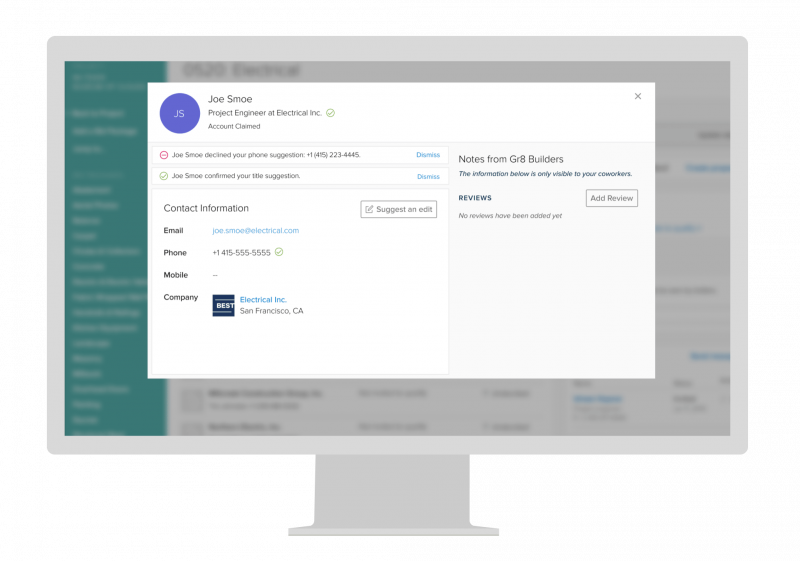
BuildingConnected Pro
Builders Network | Suggested Edits Improvements
BuildingConnected users that “suggest an edit” to another user’s profile can (1) see the status of the suggested edit (whether confirmed or declined) and (2) see or use the suggested edit throughout parts of the platform while the status is pending. This adds a layer of transparency and continues to showcase the power of the crowdsourced Builders Network.
TradeTapp
Exportable Blank Questionnaire
Whether a qualification questionnaire needs to be internally reviewed, a risk manager needs to guide a sub through a specific question on their custom form, or a trade partner needs a reference for document preparation — blank versions of all questionnaires in your TradeTapp account are now readily available to you anytime. Simply select the one you want, and export it to your computer.
Custom Email Templates
When communicating with subcontractors in TradeTapp, you can now use pre-built email templates to save you time. Create and store as many templates as you’d like in your TradeTapp account and easily access them when you need them.
BIM 360
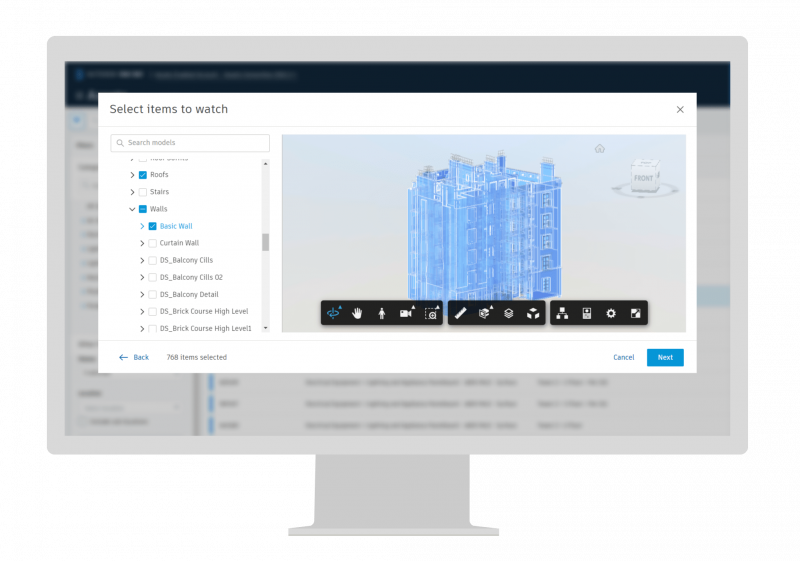
Admin Console | Limit Company Creation to Account Admins
BIM 360 users now have the option to limit the ability to create new companies to just account admins. This will eliminate the accidental creation or duplication of companies and standardize the company directory so that it is consistent and easier to manage.
Reports | Document Log – Adding Approval Status
BIM 360 users will now see a new field for ‘approval status’ within the Document Log report. This will help teams quickly understand what phase each document is at in the review cycle and quickly take action to push any delayed reviews forward.
BIM 360 Design Collaboration | Watch Groups
Design and construction teams can now monitor changes to elements of a Revit model most important to them by creating “Watch Groups” in the Change Analysis tool. Teams are automatically notified when items in watch groups change throughout the project.
This workflow enables users, especially project leads and designers, to stay informed on the most critical items they need to keep an eye on, saving time by eliminating tedious manual model queries and helping teams work smarter. Teams can also track unexpected changes within watch groups, helping to reduce risk and improve model quality overall.
Pype
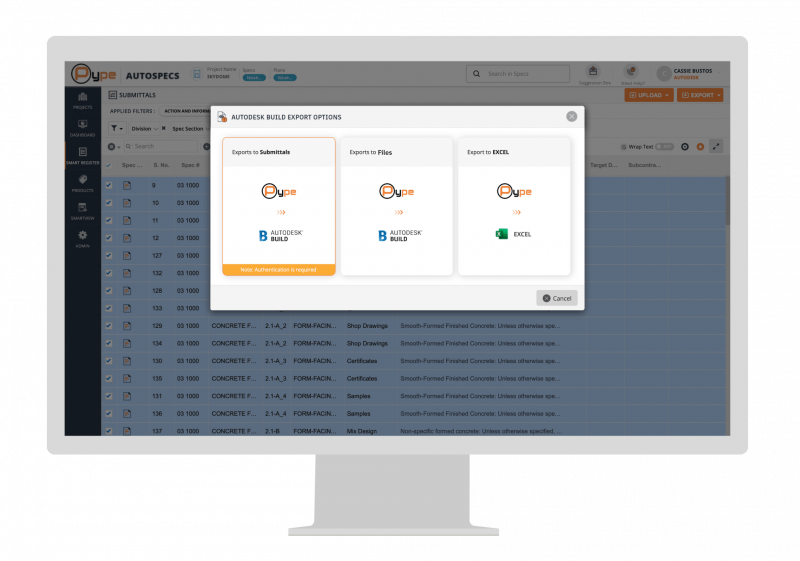
AutoSpecs | Autodesk Build Integration
Pype AutoSpecs brings efficiency, automation, and accuracy to the submittal process by automatically generating your submittal log. And now, with the Autodesk Build integration, teams can further streamline the submittal process by seamlessly transferring data from AutoSpecs directly into Autodesk Build for submittal management. Be more effective and efficient with AutoSpecs, an Autodesk Build integration.
Learn more about AutoSpecs here.
Stay in the Know for More Autodesk Construction Cloud Product Updates

The post 40+ New Product Updates for Autodesk Construction Cloud appeared first on Digital Builder.
New in Autodesk Construction Cloud: Enhance Transparency and Efficiency with Meetings Release
Meetings are essential to the success of all construction projects. Whether it be weekly coordination or OAC meetings, they are a necessary part of the design, preconstruction, and construction phases to bring multiple teams and stakeholders together to check in on action items, coordinate activities, and resolve issues.
Ensuring teams have an effective way to run a meeting, create agendas, and assign action items is just as critical to project success as work executed in the field. For example, suppose a material submittal is waiting for approval and delaying a project. In that case, the construction team can easily add an agenda item to discuss and address in their weekly OAC meeting. During the meeting, the specific submittal item can be referenced in the agenda, and the architect’s representative can easily be assigned an action item with a due date to work with relevant stakeholders and secure approval. Similarly, coordination meetings need to address complex and potentially costly clashes first, so agenda items can focus a meeting with referenced issues and status, assignee, and the associated model.
Introducing Enhanced Meeting Views
At Autodesk, our product teams are constantly building on our promise of delivering connected construction through our unified Autodesk Construction Cloud platform. This includes ensuring project teams can efficiently collaborate in every phase and project activity, including meetings. With our latest release for Meetings for Autodesk BIM Collaborate and Autodesk Build, teams can enhance transparency and ensure all meeting items are addressed and resolved.
Let’s explore how our latest product enhancement can improve how teams collaborate in meetings with new, enhanced views to organize and track meetings and meeting items.
Looking to run more effective meetings? Join our webinar on July 29 at 11:00 am – 12:00 pm PT to learn how to save time with coordination meetings with Autodesk BIM Collaborate.
Register NOW
Improved Meetings List View
Now, Autodesk BIM Collaborate and Autodesk Build users will have a new, streamlined view of all relevant meetings. All meetings will now be grouped by their relevant series, such as OAC Meetings or Coordination Meetings.
Users can click on the series to expand it to see all individual meetings in a particular series. This makes it easier to find the meeting they’re looking for and easily reference any key agenda or action items.
Check out the enhanced list view in action.
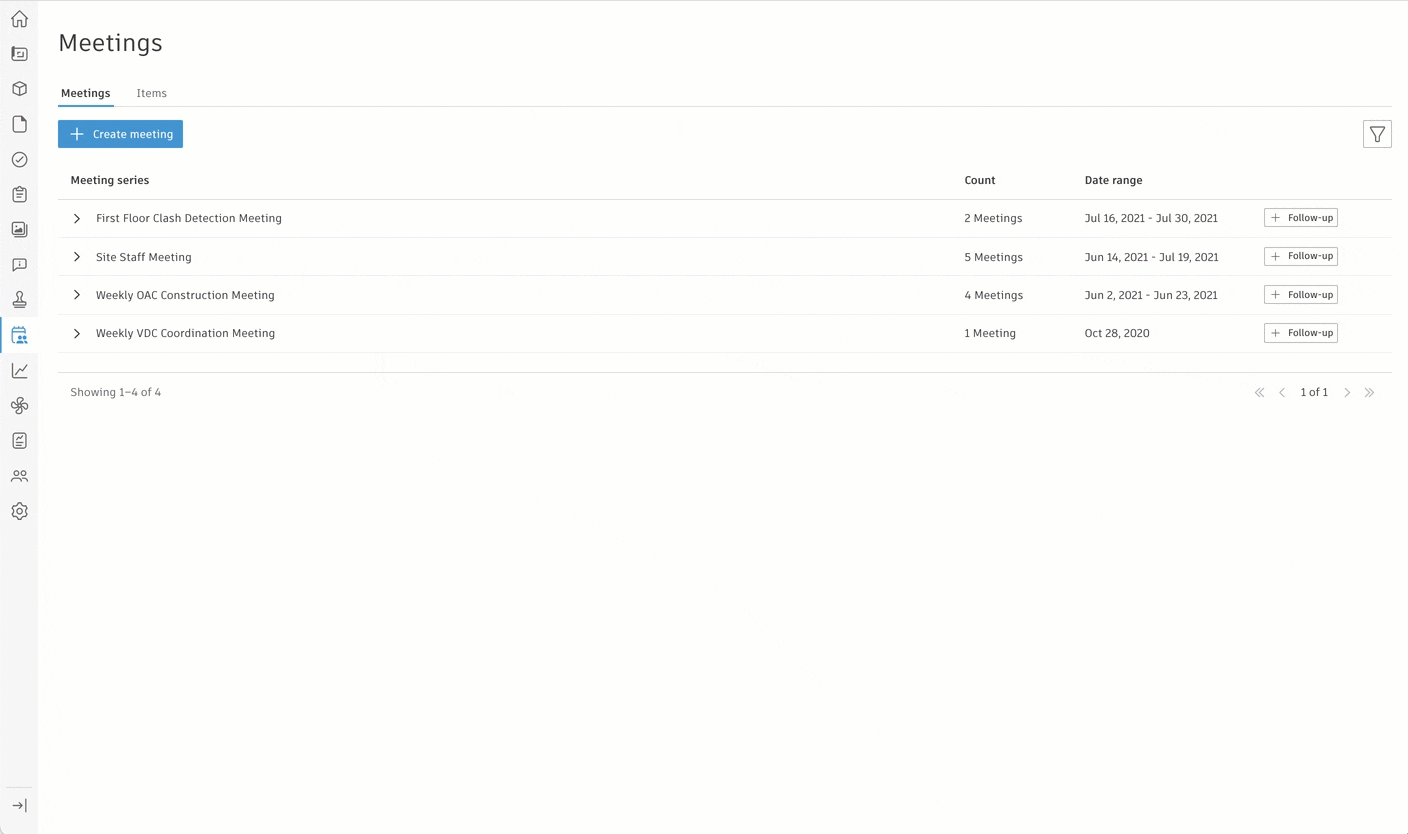
New Meeting Items View
Tracking meeting items can be a tedious task. But the new meeting items view in Autodesk BIM Collaborate and Autodesk Build simplifies tracking and makes it easier for users to manage meeting items.
The new view collates all meeting items into one list. Users can customize the view and streamline item management by sorting the list by status, meeting, or due date. Filters also enable users to easily find specific action items, status, assignees, unassigned items, due date, or items that were flagged during a meeting.
The view’s flexibility and customization make it easier to track items across a number of meetings and ensure nothing falls through the cracks.
Watch the new items view in action.
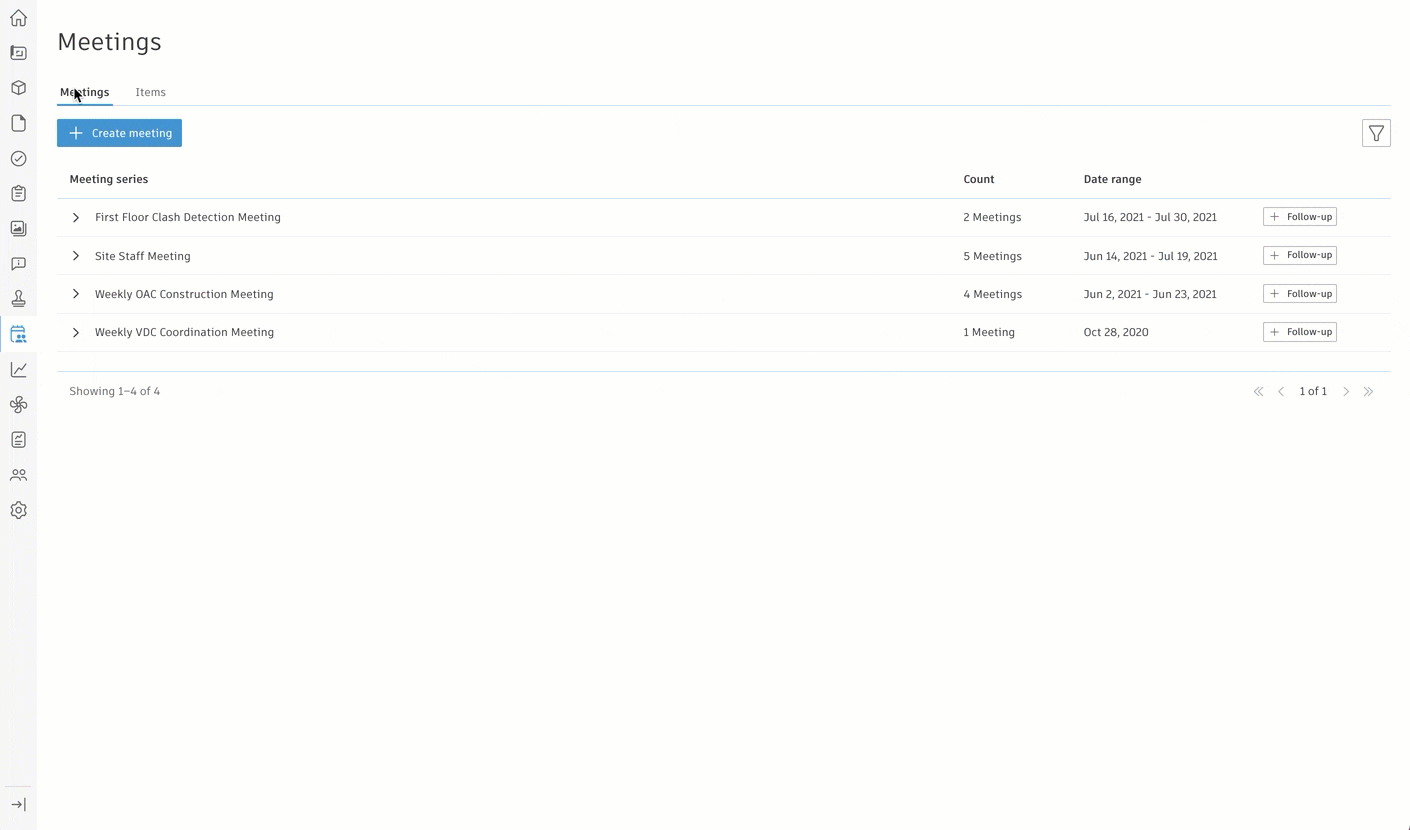
Meeting in Project Home
With so many moving parts in every construction project, it can be challenging to remember which tasks to prioritize once a meeting ends. But now, Meetings are included in Project Home for Autodesk Build users, enabling a quick view of the most relevant items and statuses.
When logging into Autodesk Build, users will see meeting items in the work status module. In “Your assigned work,” users can see the number of upcoming and overdue open or ongoing meeting items assigned to them and seamlessly jump to a view of their action items. In “Project assigned work,” users can see the number of open or ongoing meeting items and click to jump to a view of those items.
With Meetings in Project Home, individuals and teams can more easily track and resolve open meeting items.
See the project home view in action.
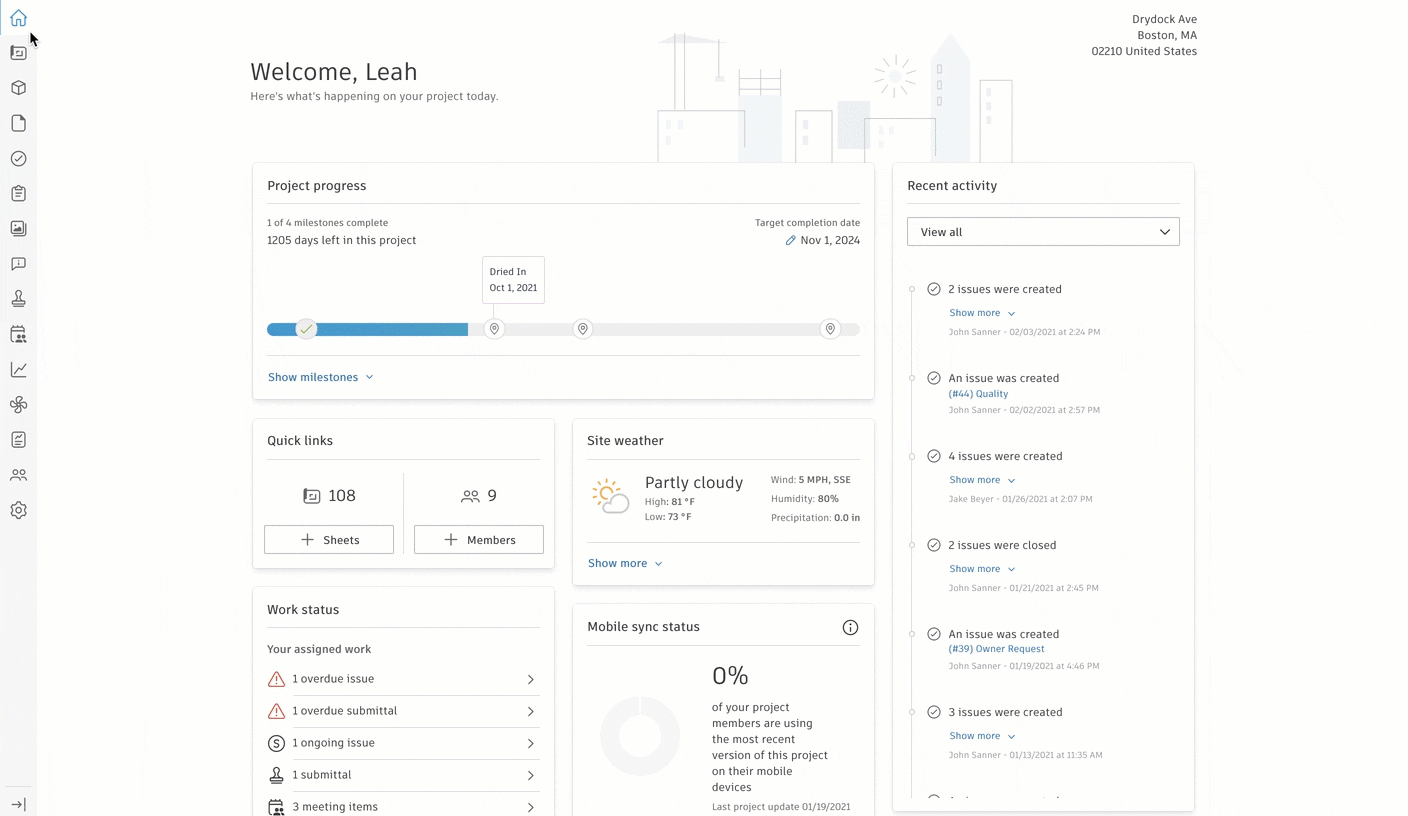
Run More Effective Meetings with Autodesk Construction Cloud
The new Meetings release isn’t the only way that Autodesk Construction Cloud unified platform helps teams increase transparency and run more effective meetings. For instance, with project references, teams can link Files, Photos, Issues, Sheets, Models, and much more to ensure relevant information is quickly and easily accessible, leading to more effective and productive conversations.
Additionally, with the Zoom integration, teams can easily add in the video conference link and ensure that remote members can attend, participate, and collaborate in meetings. And with a unified platform, owners and other stakeholders always have insight and visibility into past project decisions and documentation captured throughout a project’s lifecycle.
If you’re looking to enhance meetings, don’t forget to register for our webinar, “How to Run an Effective Coordination Meeting,” on Thursday, July 29 from 11:00 am – 12:00 pm PT to get useful tips on stakeholder expectations, prework, agenda creation, guidelines to remain focused, and follow-through.
Register NOW
Learn more about all updates across Autodesk Construction Cloud this month in our blog.
The post New in Autodesk Construction Cloud: Enhance Transparency and Efficiency with Meetings Release appeared first on Digital Builder.
Register Now for Autodesk University 2021
2020 was a major transition period for construction, but 2021 is arguably an even more pivotal year for the industry.
If the previous year was all about adopting new tools and ways of doing things, 2021 is one that’s focused on applying the lessons and solutions we picked up in 2020 and figuring out how they fit into today’s new normal.
With more tools, innovations, and insights than ever before, now is the perfect time for construction firms to invest in continuous learning opportunities for their employees.
Enter Autodesk University 2021, the premier conference that brings together top professionals in architecture, engineering, and construction.
Between October 5-14, 2021, the event promises to be an unforgettable experience packed with learning and networking opportunities. You’ll get the chance to attend various keynotes, as well as live and on-demand sessions. Plus, you’ll get to connect with fellow construction professionals from all over the globe.
Register today and mark your calendar!
REGISTER
AU 2021 is a must-attend event for all construction professionals who want to advance their careers. There will be keynote sessions, classes, and workshops covering multiple topics within construction in addition to topics on architecture, engineering, and manufacturing and how they are impacting what you do. No matter what your role is or where you are in your career, you’ll certainly pick up valuable knowledge, skills, and opportunities by attending.
This year, Autodesk University is taking place on the following dates:
- October 5 – 7: Americas
- October 6 – 8: EMEA and APAC (Australia and New Zealand, India)
- October 13 – 14: East Asia (China, Japan, Korea)
It’s a truly global event designed to cater to all attendees, no matter where you’re coming from. Select sessions will be available in multiple languages and English, including German, Japanese, Chinese, Korean, Russian, Spanish, and French.
If registration is currently unavailable for your region or language, please check back in the coming weeks.
Why Attend AU 2021?
Staying stagnant isn’t an option if you want to progress in such a dynamic field like construction. Keeping yourself abreast with updates on recent trends and developments, as well as surrounding yourself with like-minded peers, will open you up to new ideas and innovations — all of which can help you be more competitive in the industry.
As for why you should attend AU 2021 specifically, here are just a few ways that this no-cost event can benefit you and your organization.
Learn from Experts
AU 2021 offers a range of keynotes, workshops, and live panels led by industry and product experts who are at the forefront of construction innovation. Not only will you have the opportunity to hear from them, you can also get your questions answered and participate in highly interactive sessions.
Be the First to Hear Exciting Autodesk News
Connect with the very people behind the products you use every day — including the latest news and updates for Autodesk Construction Cloud unified platform.Key Autodesk product professionals, specialists, and industry enthusiasts will take the stage and provide updates and tips to help you get the most out of your software. Whether you’re a product expert or just getting started with Autodesk software, you’ll want to tune in.
Advance Your Career
If you want to know what’s next in construction and future-proof your organization, AU 2021 has got you covered. The event will fill you in on emerging construction technology, trends, and ideas shaping the future of our industry. You’ll walk away with information that you can apply both at a strategic and tactical level, ensuring that your company doesn’t get left behind.
How to Register
Autodesk University 2021 is no cost to attend, though you need to register in order to access the sessions and resources offered by the event. Just use your Autodesk account to sign up for AU 2021.
If you don’t have an account yet, simply visit the Autodesk website to create one. From there, head to the registration page and enter your name and email.
REGISTER NOW
How to Plan Your Schedule
Autodesk University 2021 will offer hundreds of sessions. We want to make sure that you’re able to catch the ones most relevant to your needs, so we’ll curate session paths for specific interests and job roles. Stay tuned for more information over the next few weeks and get details on how you can design an AU 2021 experience that’s tailored to your needs.
To ensure you don’t miss any updates, subscribe to our blog and keep an eye out for event updates and session recommendations.
Looking forward to seeing you there!
The post Register Now for Autodesk University 2021 appeared first on Digital Builder.
APIJ Construction: Critical Role of Technology in “Response” Phase of COVID-19
The effects of COVID-19 on the construction industry across Asia Pacific including Japan (APIJ) are varied, and the recovery for construction companies across the region can be classified into three phases: “response”, “adaptation”, and “acceleration”. In this blog, we’ll dive into the “response” phase including a look at the technology the industry is adopting for this part of their recovery.
Each phase of recovery is accompanied by specific technology investments construction companies must make to aid their recovery — from initiating projects to reducing costs to survive, to adapting technologies to address gaps and new pandemic-induced requirements, and using new innovations to capture market share.
A recent IDC InfoBrief, sponsored by Autodesk, Road to Recovery: Overcoming COVID-19’s Impact on the Construction Industry with Digital Technologies, looks at each of these phases including the top technology investments at each stage of recovery. The InfoBrief found that 18% of construction companies surveyed across the region are in the crisis response phase and looking at technology projects that reduce operating costs, while 16% are looking at technology projects that react to the crisis brought on by COVID-19 (for example, technology to support business continuity like video conferencing tools).
The goal of construction companies in the “response” phase
The goal of construction companies in the “response” phase is to ensure the workforce remains connected, engaged, and most of all, safe. A shift in mindset among construction companies in this phase is a must; management must recognise employee outcomes play a more significant role in crisis response over adherence to processes.
Construction companies in the “response” phase were caught unprepared by COVID-19 and are still managing its business impact. The companies in this phase were only making short-term, tactical technology investments and did not have a digital roadmap prior to the pandemic, therefore they had to pivot more quickly than their peers in order to survive. These organisations found they were lacking the resilience needed to support their workforce and are striving to equip workers with the necessary technologies to ensure business continuity.
While the percentage of employees working in the field has decreased from 43% in pre-pandemic days to just 26%, these organisations need to make investments that will ensure the health and safety of employees when businesses increase onsite operations. The shift from a physical to digital workplace is a must in order to reduce human intervention and establish autonomous operations, and at the same time, ensure productivity and engagement from employees.
3 top technology investments in the “response” phase
The IDC InfoBrief found that of those companies surveyed, the top three technology investments in the “response” phase were:
- Video conferencing applications (35%)
- Dedicated health and security applications for employee communication and contact tracing (32%)
- Employee engagement (31%)
To support the workforce, construction companies must establish technology parity, where all workers have secure access to the resources required to do their jobs, no matter their preferred device or if they are local, remote, or in the field. The top three technology investments reflect this focus, in addition to ensuring the workforce is connected, engaged and safe. While these initial steps are tactical, they are the foundations a company needs to ensure business continuity before moving into the “adaptation” phase where business goals and accompanying technology investments can shift into long term, strategic goals to protect companies against further disruptions.
Technology is supporting construction companies with resilience through each phase of COVID-19 recovery
In a new era of convergence where industries, processes and teams are embracing innovative ways of working and dealing with new challenges, streamlined workflows are possible through software such as the solutions within Autodesk Construction Cloud, an integrated cloud-based portfolio of products used to manage construction projects. Autodesk Construction Cloud connects workflows, teams and data at every stage of construction to reduce risk, maximise efficiency and increase profits.
The unified technology offered by Autodesk Construction Cloud is becoming increasingly important for companies to support COVID-19 recovery, and we are working with our customers to support them through their journey to recovery, growth and beyond.
To download the IDC InfoBrief, click here. To find out more about how Autodesk Construction Cloud can support your business, contact us or get your free trial.
The post APIJ Construction: Critical Role of Technology in “Response” Phase of COVID-19 appeared first on Digital Builder.
Did you miss our previous article…
https://www.arizonasolarsociety.com/?p=37